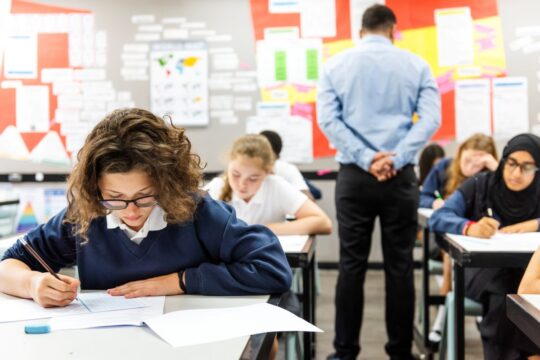Some classroom strategies stick around for a reason, and Think-Pair-Share — a cooperative learning approach — is one of them. Whether you’re teaching elementary students or high schoolers, this strategy works for everyone. It doesn’t require any preparation, and when utilized intentionally, it can completely transform the way students process and engage with the content.
Here we’ll break down why this strategy is worth using, how it benefits your students in real, noticeable ways, and simple ways to start implementing it into your lessons without making more work for yourself.
What Is Think-Pair-Share?
Think-Pair-Share is a three-step discussion routine that helps students build confidence in their ideas before they share them with a larger group.
Here’s the breakdown:
- Think – Students take a moment to reflect on a question or prompt independently.
- Pair – They turn to a partner and talk through their thoughts.
- Share – Pairs then share with the whole class or a small group.
There are no worksheets, no tech tools, and no setup. It’s a simple strategy that makes a huge impact.
The Benefits of Think-Pair-Share
Here’s how Think-Pair-Share can transform your classroom into a place where every student feels seen, heard, and ready to engage.
It Gives Every Student a Voice
There are always going to be some students who will always raise their hands, while others stay quiet, no matter how many times you make eye contact or toss encouragement their way. Think-Pair-Share levels the playing field.
The “think” step gives introverted students or English language learners time to gather their thoughts, while the “pair” stage gives students a low-key way to talk through their ideas and see if they make sense before sharing them with the whole group.
When it comes time to “share,” even hesitant students feel more prepared because they’ve already said the words out loud once. They’re not being put on the spot; they’re just continuing a conversation they already had with a classmate.
It Gets Everyone Talking and Listening
In so many classrooms, it’s the same few kids doing all the talking while everyone else checks out. Think-Pair-Share changes that. It gives all students a reason to join in—talking, listening, and bouncing ideas off each other.
Over time, you’ll hear students say things like, “My partner said something interesting…” or “I didn’t think of it that way until we talked.” That’s when you know they’re not just chatting, they’re building real conversation skills.
It Builds Confidence and Gets Students Thinking More Deeply
When you ask a question, like “Why do you think the character did that?” or “What impact does climate change have on different places?”—some kids freeze up. It’s not that they don’t have ideas; they’re just not sure if they’re on the right track.
The “think” part of the strategy gives students space to process without pressure. Then the “pair” part acts like a rehearsal. They get to talk it out with a partner first, which helps them feel more ready (and more confident) when it’s time to share with the class. Even if their answer isn’t perfect, they still feel like they have something to say, and that matters.
You Can Use It Anywhere, With Any Grade
Think-Pair-Share isn’t tied to one subject, it works anywhere. Use it in math to talk through different ways to solve a problem, in science to make predictions, in reading to dive into character choices, or in social studies to unpack big ideas like fairness or impact.
Whether you’re teaching little ones or older students, it just fits. The best part is you can make it as simple or as detailed as you want, depending on your teaching style and your class. It’s flexible, low-prep, and easy to make your own.
For example, during a science lesson on ecosystems, you might ask students to think about how climate change could affect a food chain, pair up to compare ideas, and then share their conclusions with the class.
How to Implement Think-Pair-Share in Your Lessons
If you’re just getting started with this strategy or want to get more out of it, here are a few ways to make it work for your classroom.
Start with a Strong Prompt
The way you ask questions matters. If you want students to really think and talk, you’ve got to start with a solid question. Skip the yes/no stuff or anything they can just copy from the board. Go for open-ended prompts that make them reflect, explain, or take a stance. Try things like:
- “What’s one mistake the character made, and what could they have done differently?”
- “Which solution do you think works better, and what makes you say that?”
- “How would you explain this to someone younger who’s never heard of it before?”
These types of questions not only get students thinking but also give them something to discuss. That’s when you’ll see the magic happen.
Be Clear About What You Expect
Before you use Think-Pair-Share, make sure your students know exactly what they’re supposed to do in each step. Let them know how long they’ll have to think quietly, what it looks like to be a respectful partner, and whether they’ll be sharing with the whole class or just in small groups.
Model it early on so they know what it should sound like. You can even walk through an example of what a strong partner conversation looks like and what to avoid. For instance, show how one partner might just shrug and say, “I don’t know,” while the other says, “I think the character made that choice because she felt left out—what do you think?”
That little difference shows what active participation actually sounds like. A quick tip like, “Listen for one good idea from your partner you can share later,” helps keep them focused and accountable.
Use Timers or Visual Cues
Use timers or cues, especially in the beginning when students may need help managing the pacing. Something like turning lights on and off or using a slide deck with countdowns to guide them through each step. This structure helps things run smoothly and keeps the energy up.
Mix Up the Pairings
Don’t let students always pair with their close friends. Rotating partners regularly ensure that all students get exposure to different perspectives and that no one feels left out. Use tools like partner wheels, number matchups, or even random name generators to switch it up in a fun way.
Keep It Moving
Think-Pair-Share doesn’t have to be long or formal. Use it as a warm-up, an exit ticket, a brain break, or a way to bridge into a bigger activity. Once it becomes part of your routine, students will expect it and may even look forward to it.
Think-Pair-Share is one of those teaching strategies that works just as well today as it did when it first made its way into classrooms in the 1980s. It supports a wide range of learners, builds communication and collaboration, and gives students something all kids deserve: a chance to be heard.
Educators never stop learning; check out our available graduate degree programs to hone your skills and promote lifelong learning and academic excellence.




